Hydrothermally Altered Rocks and Their Implications for Debris Flow Generation in the Monarch Butterfly Biosphere Reserve, Mexico
Abstract
1. Introduction
2. Materials and Methods
2.1. Geological Settings
2.2. Local Geology
2.3. Climate Conditions
2.4. Description of Landslide
2.5. Methodology
Field Work and Sampling
3. Results
4. Discussion
5. Conclusions
Author Contributions
Funding
Data Availability Statement
Acknowledgments
Conflicts of Interest
References
- Froude, M.J.; Petley, D.N. Global fatal landslide occurrence from 2004 to 2016. Nat. Hazards Earth Syst. Sci. 2018, 18, 2161–2181. [Google Scholar] [CrossRef]
- Marin, R.J.; García, E.F.; Aristizábal, E. Effect of basin morphometric parameters on physically-based rainfall thresholds for shallow landslides. Eng. Geol. 2020, 278, 105855. [Google Scholar] [CrossRef]
- Chaithong, T. Assessing the impact of climate change on landslide recurrence intervals in Nakhon Si Thammarat Province, Thailand, using CMIP6 climate models. Prog. Disaster 2024, 22, 100330. [Google Scholar] [CrossRef]
- Modugno, S.; Johnson, S.C.M.; Borrelli, P.; Alam, E.; Bezak, N.; Balzter, H. Analysis of human exposure to landslides with a GIS multiscale approach. Nat. Hazards 2022, 112, 387–412. [Google Scholar] [CrossRef]
- Díaz, S.R.; Cadena, E.; Adame, S.; Dávila, N. Landslides in Mexico: Their occurrence and social impact since 1935. Landslides 2020, 17, 379–394. [Google Scholar] [CrossRef]
- Macías, J.L. Geología e historia eruptiva de algunos de los grandes volcanes activos de México. Bol. Soc. Geol. Mex. 2005, 57, 379–424. [Google Scholar] [CrossRef]
- Frolova, J.V.; Ladygin, V.M.; Rychagov, S.N. Petrophysical Alteration of Volcanic Rocks in Hydrothermal Systems of the Kuril-Kamchatka Island Arc. In Proceedings of the World Geothermal Congress 2010, Bali, Indonesia, 25–29 April 2010; Available online: https://www.researchgate.net/publication/268266181_Petrophysical_Alteration_of_Volcanic_Rocks_in_Hydrothermal_Systems_of_the_Kuril-_Kamchatka_Island_Arc (accessed on 10 May 2024).
- Siratovich, P.A.; Heap, M.J.; Villeneuve, M.C.; Cole, J.W.; Kennedy, B.M.; Davidson, J.; Reuschl’e, T. Mechanical behaviour of the Rotokawa Andesites (New Zealand): Insight into permeability evolution and stress-induced behaviour in an actively utilised geothermal reservoir. Geothermics 2016, 64, 163–179. [Google Scholar] [CrossRef]
- Kennedy, B.M.; Farquhar, A.; Hilderman, R.; Villeneuve, M.C.; Heap, M.J.; Mordensky, S.; Kilgour, G.; Jolly, A.; Christenson, A.; Reuschl’e, R. Pressure controlled permeability in a conduit filled with fractured hydrothermal breccia reconstructed from Ballistics from Whakaari (White Island), New Zealand. Geosciences 2020, 10, 138. [Google Scholar] [CrossRef]
- Heap, M.J.; Kennedy, B.M.; Farquharson, J.I.; Ashworth, J.; Mayer, K.; Letham-Brake, M.; Reuschl’e, T.; Gilg, H.A.; Scheu, B.; Lavall’ee, Y.; et al. A multidisciplinary approach to quantify the permeability of the Whakaari/White Island volcanic hydrothermal system (Taupo Volcanic Zone, New Zealand). J. Volcanol. Geotherm. Res. 2017, 332, 88–108. [Google Scholar] [CrossRef]
- Farquharson, J.I.; Wild, B.; Kushnir, A.R.L.; Heap, M.J.; Baud, P.; Kennedy, B. Acid-induced dissolution of andesite: Evolution of permeability and strength. J. Geophys. Res. Solid Earth 2019, 124, 257–273. [Google Scholar] [CrossRef]
- Callahan, O.A.; Eichhubl, P.; Olson, J.E.; Davatzes, N.C. Fracture mechanical properties of damaged and hydrothermally altered rocks, Dixie Valley-Stillwater fault zone, Nevada, USA. J. Geophys. Res. Solid Earth 2019, 124, 4069–4090. [Google Scholar] [CrossRef]
- Cassidy, M.; Manga, M.; Cashman, K.; Bachmann, O.; Loewen, M. Controls on explosive-effusive volcanic eruption styles. Nat. Commun. 2018, 9, 2839. [Google Scholar] [CrossRef]
- Heap, M.J.; Troll, V.R.; Kushnir, A.R.; Gilg, H.A.; Collinson, A.S.; Deegan, F.M.; Darmawan, H.; Nadhirah Seraphine, N.; Neuberg, J.; Walter, T.R. Hydrothermal alteration promotes rapid pore-pressure rise and explosive eruption in silicic systems. Geophys. Res. Lett. 2019, 46, 17–18. [Google Scholar] [CrossRef]
- Mordensky, S.P.; Heap, M.J.; Kennedy, B.M.; Villeneuve, M.C.; Gravley, D.M.; Farquharson, J.I.; Reuschl’e, T. Influence of alteration on the mechanical behaviour and failure mode of andesite: Implications for shallow seismicity and volcano monitoring. Bull. Volcanol. 2019, 81, 44. [Google Scholar] [CrossRef]
- Reid, M.E.; Sisson, T.W.; Brien, D.L. Volcano collapse promoted by hydrothermal alteration and edifice shape, Mount Rainier, Washington. Geology 2001, 29, 779–782. [Google Scholar] [CrossRef]
- Coggan, J.S.; Stead, D.; Howe, J.H.; Faulks, C.I. 2013. Mineralogical controls on the engineering behavior of hydrothermally altered granites under uniaxial compression. Eng. Geol. 2013, 160, 89–102. [Google Scholar] [CrossRef]
- Villeneuve, M.; Kennedy, B.; Gravley, D.; Mordensky, S.; Heap, M.J.; Siratovich, P.; Wyering, L.; Cant, J. Characteristics of altered volcanic rocks in geothermal reservoirs. In Rock Mechanics for Natural Resources and Infrastructure Development; Da Fontoura, S.A.B., Rocca, R.J., Mendoza, J.F.P., Eds.; CRC Press: Boca Raton, FL, USA, 2019. [Google Scholar] [CrossRef]
- Heap, M.J.; Baumann, T.S.; Rosas-Carbajal, M.; Komorowski, J.-C.; Gilg, H.A.; Villeneuve, M.; Moretti, R.; Baud, P.; Carbillet, L.; Harnett, C.; et al. Alteration-induced volcano instability at La Soufri’ere de Guadeloupe (Eastern Caribbean). J. Geophys. Res. Solid Earth 2021, 126, e2021JB022514. [Google Scholar] [CrossRef]
- John, D.A.; Sisson, T.W.; Breit, G.N.; Rye, R.O.; Vallance, J.W. Characteristics, extent and origin of hydrothermal alteration at Mount Rainier Volcano, Cascades Arc, USA: Implications for debris-flow hazards and mineral deposits. J. Volcanol. Geotherm. Res. 2008, 175, 289–314. [Google Scholar] [CrossRef]
- Tamura, E.; Shuichi Hasegawa, S.; Watanabe, H.; Miyata, K.; Yatabe, R.; Uchida, J. Effect of Hydrothermal Alteration on landslides along the Median Tectonic Line. J. Jpn. Landslide Soc. 2007, 44, 222–236. [Google Scholar] [CrossRef][Green Version]
- Alcántara-Ayala, I.; López-García, J.; Garnica, R.J. On the landslide event in 2010 in the Monarch Butterfly Biosphere Reserve, Angangueo, Michoacán, Mexico. Landslides 2012, 9, 263–273. [Google Scholar] [CrossRef]
- Diario Oficial de la Federación, Declaratoria de Desastre Natural Por la Ocurrencia de Lluvias Severas los Días 3 y 4 de Febrero, en 5 Municipios del Estado de Michoacán de Ocampo. 2010. Available online: https://dof.gob.mx/nota_detalle.php?codigo=5131662&fecha=12/02/2010#gsc.tab=0 (accessed on 6 September 2024).
- Li, Y.; Mo, P. A unified landslide classification system for loess slopes: A critical review. Geomorphology 2019, 340, 67–83. [Google Scholar] [CrossRef]
- Ostrooumov, M. Mineralogía de los Yacimientos Hidrotermales de Mediana Temperatura en Angangueo, Michoacán, México. Available online: www.researchgate.net/publication/269986955 (accessed on 10 November 2023).
- Ferrari, L.; Orozco-Esquivel, T.; Manea, V.; Manea, M. The dynamic history of the Trans-Mexican Volcanic Belt and the Mexico subduction zone. Tectonophysics 2012, 522–523, 122–149. [Google Scholar] [CrossRef]
- Pasquarè, G.; Ferrari, L.; Garduño-Monroy, V.H.; Tibaldi, A.; Vezzoli, L. Geology of the central sector of the Mexican Volcanic belt, States of Guanajuato and Michoacán. GSA Map Chart Ser. MCH 1991, 72, 20. [Google Scholar]
- Hernández-Bernal, M.d.S.; Corona-Chávez, P.; Solís-Pichardo, G.; Schaaf, P.; Solé-Viñas, J.; Molina, J.F. Miocene andesitic lavas of Sierra de Angangueo: A petrological, geochemical, and geochronological approach to arc magmatism in Central Mexico. Int. Geolg Rev. 2016, 58, 603–625. [Google Scholar] [CrossRef]
- López-García, J.; Alcántara-Ayala, I. Land-use change and hillslope instability in the monarch butterfly biosphere reserve, central Mexico. Land. Degrad. Dev. 2012, 23, 384–397. [Google Scholar] [CrossRef]
- Morales, D.L.; Castañeda, M.A.; González, H.A.E. Análisis de Umbrales de Lluvia Que Detonan Deslizamientos y Sus Posibles Aplicaciones en un Sistema de Alerta Temprana Por Inestabilidad de Laderas. 2016. Available online: http://www1.cenapred.unam.mx/COORDINACION_ADMINISTRATIVA/SRM/FRACCION_XLI_A/23.pdf (accessed on 12 March 2024).
- Emberson, R.; Kirschbaum, D.; Stanley, T. Global connections between El Nino and landslide impacts. Nat. Commun. 2021, 12, 1–11. [Google Scholar] [CrossRef]
- SMN, Servicio Metereológico Nacional. Available online: https://smn.conagua.gob.mx/es/climatologia/informacion-climatologica/informacion-estadistica-climatologica (accessed on 13 January 2024).
- ASTM D4543-19; Standard Practices for Preparing Rock Core Specimens and Determining Dimensional and Shape Tolerances. ASTM International: West Conshohocken, PA, USA, 2019. Available online: https://store.astm.org/d4543-19.html (accessed on 17 July 2024).
- ASTM D5550-23; Standard Test Method for Specific Gravity of Soil Solids by Gas Pycnometer. ASTM International: West Conshohocken, PA, USA, 2023. Available online: https://store.astm.org/d5550-23.html (accessed on 17 July 2024).
- ASTM D4525-13e2; Standard Test Method for Permeability of Rocks by Flowing Air. ASTM International: West Conshohocken, PA, USA, 2013. Available online: https://store.astm.org/d4525-13e02.html (accessed on 17 July 2024).
- Sander, R.; Pan, Z.; Connell, L.D. Laboratory measurement of low permeability unconventional gas reservoir rocks: A review of experimental methods. J. Nat. Gas. Sci. Eng. 2017, 37, 248–279. [Google Scholar] [CrossRef]
- ASTM D3967-23; Standard Test Method for Splitting Tensile Strength of Intact Rock Core Specimens with Flat Loading Platens. ASTM International: West Conshohocken, PA, USA, 2016. Available online: https://store.astm.org/d3967-23.html (accessed on 17 July 2024).
- ASTM D2938-95; Standard Test Methods for Unconfined Compressive Strength of Intact Rock Core Specimens. ASTM International: West Conshohocken, PA, USA, 2002. Available online: https://store.astm.org/d2938-95.html (accessed on 17 July 2024).
- ASTM D7012-23; Standard Test Methods for Compressive Strength and Elastic Moduli of Intact Rock Core Specimens Under Varying States of Stress and Temperatures. ASTM International: West Conshohocken, PA, USA, 2023. Available online: https://store.astm.org/d7012-23.html (accessed on 17 July 2024).
- Heap, M.J.; Harnett, C.E.; Wadsworth, F.B.; Gilg, H.A.; Carbillet, L.; Rosas-Carbajal, M.; Komorowski, J.C.; Baud, P.; Troll, V.R.; Deegan, F.M.; et al. The tensile strength of hydrothermally altered volcanic rocks. J. Volcanol. Geotherm. Res. 2022, 428, 107576. [Google Scholar] [CrossRef]
- Knopp, J.; Steger, H.; Moormann, C.; Blum, P. Influence of Weathering on Pore Size Distribution of Soft Rocks. Geotech. Geol. Eng. 2022, 40, 5333–5346. [Google Scholar] [CrossRef]
- Jones, J.N.; Boulton, S.J.; Stokes, M.; Bennett, G.L.; Whitworth, M.R.Z. 30-year record of Himalaya mass-wasting reveals landscape perturbations by extreme events. Nat. Commun. 2021, 12. [Google Scholar] [CrossRef]
- Sánchez-Núñez, J.M.; Pola, A.; Cisneros, G.; Sereno, H.I.; Serrano-flores, M.E.; Jiménez, L.Á.; Rodríguez, P. Physical-mechanical behavior of fresh and completely altered rocks as an important factor of slope instability in the El Rosario Monarch Butterfly Sanctuary, Michoacán, Mexico. Rev. Mex. Cienc. Geológicas 2021, 38, 272–282. [Google Scholar] [CrossRef]
- Zhang, S.; Cao, K.; Wang, C.; Wang, X.; Deng, G.; Wei, P. Influence of the porosity and pore size on the compressive and splitting strengths of cellular concrete with millimeter-size pores. Constr. Build. Mater. 2020, 235, 117508. [Google Scholar] [CrossRef]
- Zhou, B.; Lu, N. Correlation between Atterberg Limits and Soil Adsorptive Water. J. Geotech. Geoenviron. Eng. 2021, 147, 04020162. [Google Scholar] [CrossRef]
- Avşar, E.; Ulusay, R.; Mutlutürk, M. An experimental investigation of the mechanical behavior and microstructural features of a volcanic soil (Isparta, Turkey) and stability of cut slopes in this soil. Eng. Geol. 2015, 189, 68–83. [Google Scholar] [CrossRef]
- Mordensky, S.P.; Villeneuve, M.C.; Kennedy, B.M.; Struthers, J.D. Hydrothermally induced edifice destabilisation: The mechanical behaviour of rock mass surrounding a shallow intrusion in andesitic lavas, Pinnacle Ridge, Ruapehu, New Zealand. Eng. Geol. 2022, 305, 106696. [Google Scholar] [CrossRef]
- Kereszturi, G.; Heap, M.; Schaefer, L.N.; Darmawan, H.; Deegan, F.M.; Kennedy, B.; Komorowski, J.C.; Mead, S.; Rosas-Carbajal, M.; Ryan, A.; et al. Porosity, strength, and alteration–Towards a new volcano stability assessment tool using VNIR-SWIR reflectance spectroscopy. Earth Planet. Sci. Lett. 2023, 602, 117929. [Google Scholar] [CrossRef]
- Yalcin, A. The effects of clay on landslides: A case study. Appl. Clay Sci. 2007, 38, 77–85. [Google Scholar] [CrossRef]
- Hendron, A.; Patton, F. Technical Report gl-85-5 the Vaiont Slide a Geotechnical Analysis Based on New Geologic Observations; US Army Corps of Engineers: Washington, DC, USA, 1985. [Google Scholar]
- Paronuzzi, P.; Bolla, A.; Pinto, D.; Lenaz, D.; Soccal, M. The clays involved in the 1963 Vajont landslide: Genesis and geomechanical implications. Eng. Geol. 2021, 294, 106376. [Google Scholar] [CrossRef]
- Zelenka, T.; Kovács-pálffy, P.; Trauer, N. The role of expanding clay minerals in mas s movements at hollóháza, tokaj mts. Acta Mineral. Petrogr. 2005, 46, 63–67. [Google Scholar]
- Heap, M.J.; Harnett, C.; Farquharson, J.; Baud, P.; Rosas-Carbajal, M.; Komorowski, J.C.; Violay, M.E.S.; Gilg, H.A.; Reuschlé, T. The influence of water-saturation on the strength of volcanic rocks and the stability of lava domes. J. Volcanol. Geotherm. Res. 2023, 444, 107962. [Google Scholar] [CrossRef]
- Miller, C.A.; Schaefer, L.N.; Kereszturi, G.; Fournier, D. Three-Dimensional Mapping of Mt. Ruapehu Volcano, New Zealand, from Aeromagnetic Dat Inversion and Hyperspectral Imaging. J. Geophys. Res. Solid Earth 2020, 125, e2019JB018247. [Google Scholar] [CrossRef]
- Ng, C.W.; Pang, Y.W. Influence of Stress State on Soil-Water Characteristics and Slope Stability. J. Geotech. Geoenviron. Eng. 2000, 126, 157–166. [Google Scholar] [CrossRef]
- Lu, N.; Likos, W.J. Suction Stress Characteristic Curve for Unsaturated Soil. J. Geotech. Geoenviron. Eng. 2006, 132, 131–142. [Google Scholar] [CrossRef]
- Navelot, V.; Géraud, Y.; Favier, A.; Diraison, M.; Corsini, M.; Lardeaux, J.; Verati, C.; Mercier, J.; Lépinay, D.; Legendre, L.; et al. Petrophysical properties of volcanic rocks and impacts of hydrothermal alteration in the Guadeloupe Archipelago (West Indies). J. Volcanol. Geotherm. Res. 2018, 360, 1–21. [Google Scholar] [CrossRef]
- Benavente, D.; Pla, C.; Cueto, N.; Galvañ, S.; Martínez-Martínez, J.; García-del-Cura, M.A.; Ordóñez, S. Predicting water permeability in sedimentary rocks from capillary imbibition and pore structure. Eng. Geol. 2015, 195, 301–311. [Google Scholar] [CrossRef]
- Pereira, M.L.; Zanon, V.; Fernandes, I.; Pappalardo, L.; Viveiros, F. Hydrothermal alteration and physical and mechanical properties of rocks in a volcanic environment: A review. Earth Sci. Rev. 2024, 252, 104754. [Google Scholar] [CrossRef]
- Kamal, A.S.M.M.; Hossain, F.; Rahman, M.Z.; Ahmed, B.; Sammonds, P. Geological and soil engineering properties of shallow landslides occurring in the Kutupalong Rohingya Camp in Cox’s Bazar, Bangladesh. Landslides 2022, 19, 465–478. [Google Scholar] [CrossRef]
- Çellek, S. Effect of the Slope Angle and Its Classification on Landslide. Himal. Geol. 2022, 43, 85–95. [Google Scholar] [CrossRef]
- Ma, S.; Yao, Y.; Bao, P.; Guo, C. Effects of moisture content on strength and compression properties of foundation soils of cultural relics in areas flooded by the Yellow River. Front. Mater. 2023, 10, 1186750. [Google Scholar] [CrossRef]
- Musta, B.; Karim, A.S.R.; Soehady, H.F.; Kim, K.W.; Kim, J.H. Effect of moisture on engineering properties of soil slopes from melange in Sandakan Sabah, Malaysia. ASM Sci. J. 2018, 11, 79–85. [Google Scholar]
- Govi, M.; Pasuto, A.; Silvano, S.; Siorpaes, C. An example of a low-temperature-triggered landslide. Eng. Geol. 1993, 36, 53–65. [Google Scholar] [CrossRef]
- Bogaard, T.A.; Greco, R. Landslide hydrology: From hydrology to pore pressure. Wiley Interdiscip. Rev. Water 2016, 3, 439–459. [Google Scholar] [CrossRef]
- Iverson, R.M. Landslide triggering by rain infiltration. Water Resour. Res. 2000, 36, 1897–1910. [Google Scholar] [CrossRef]
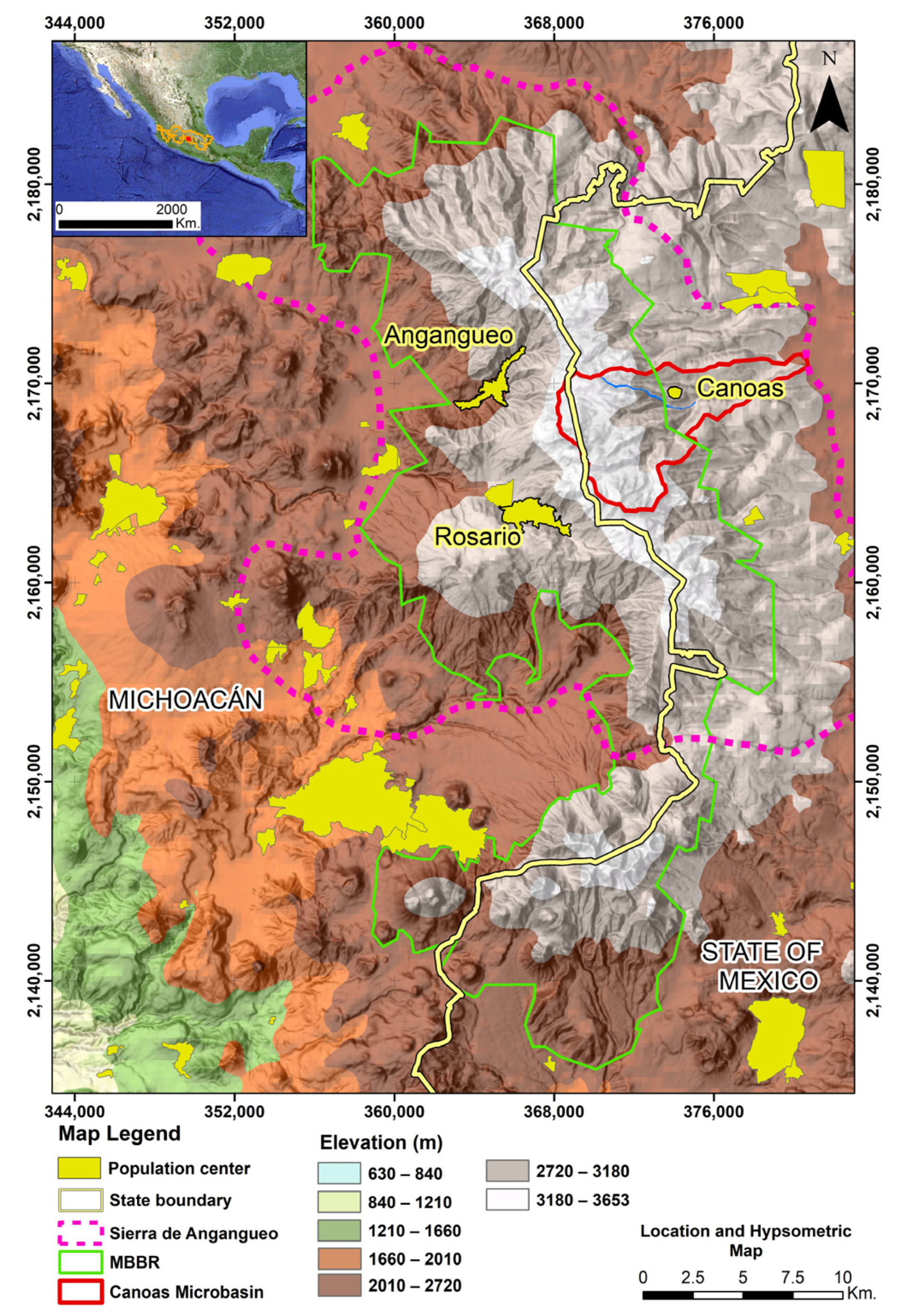
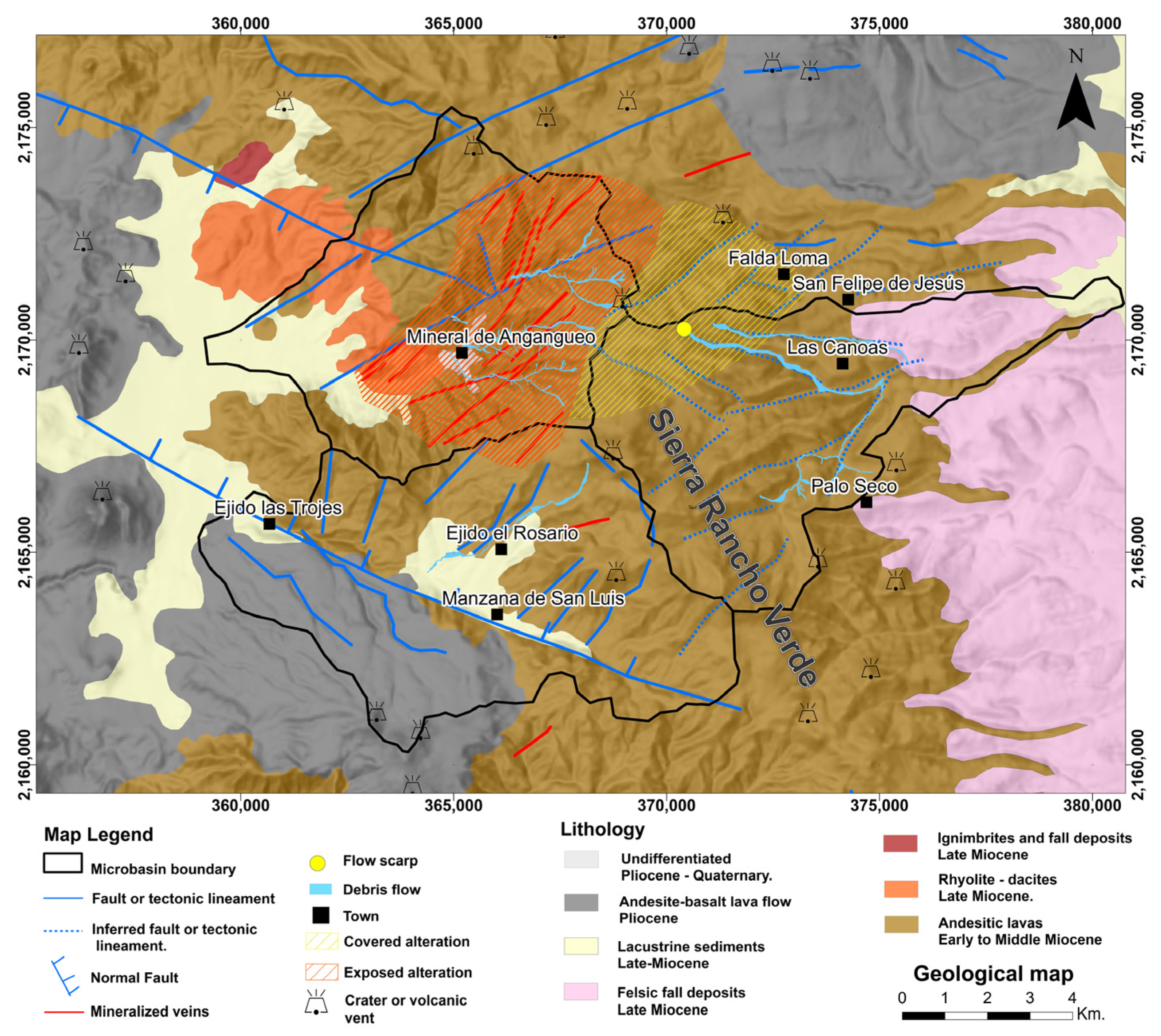
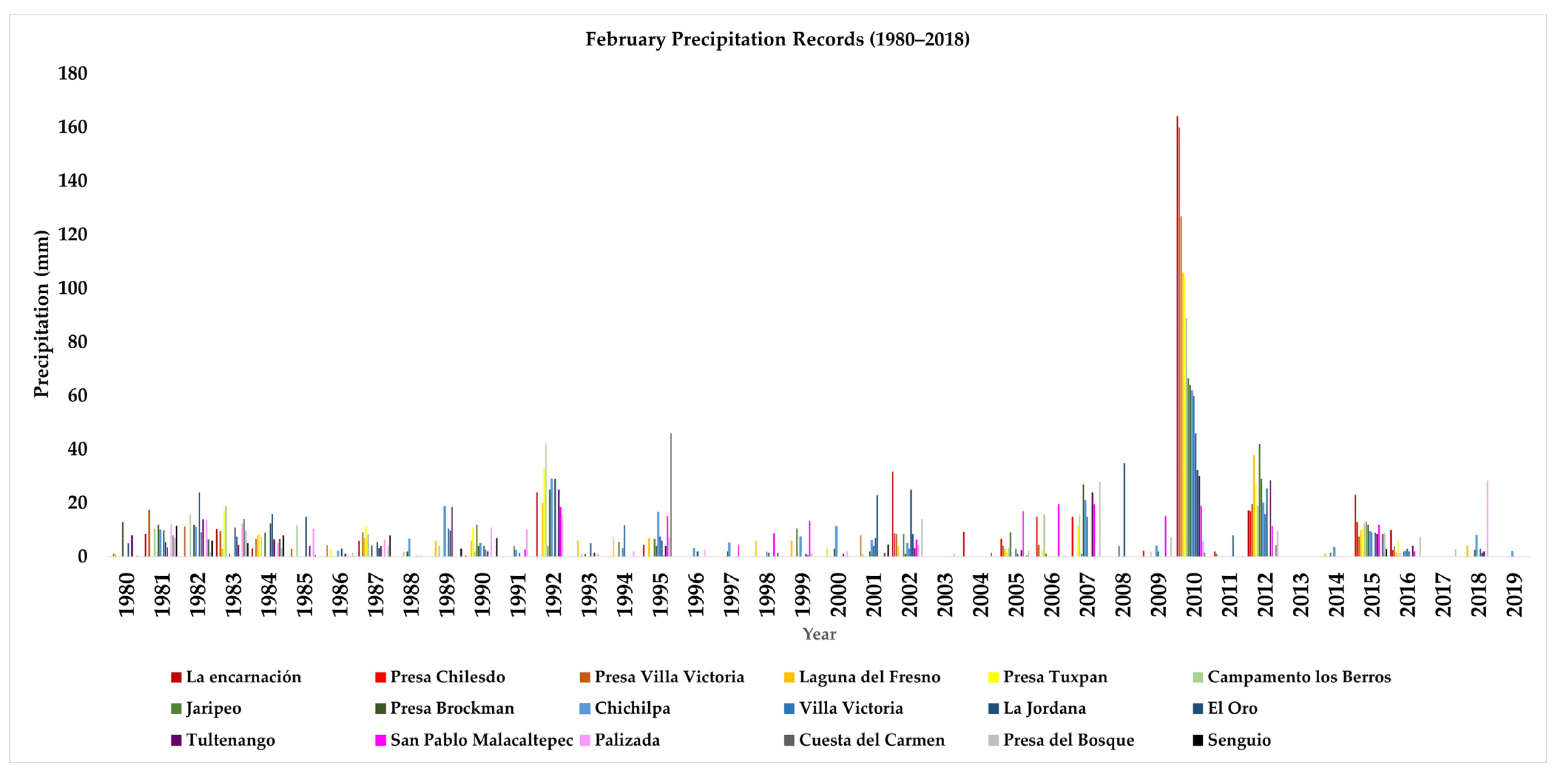

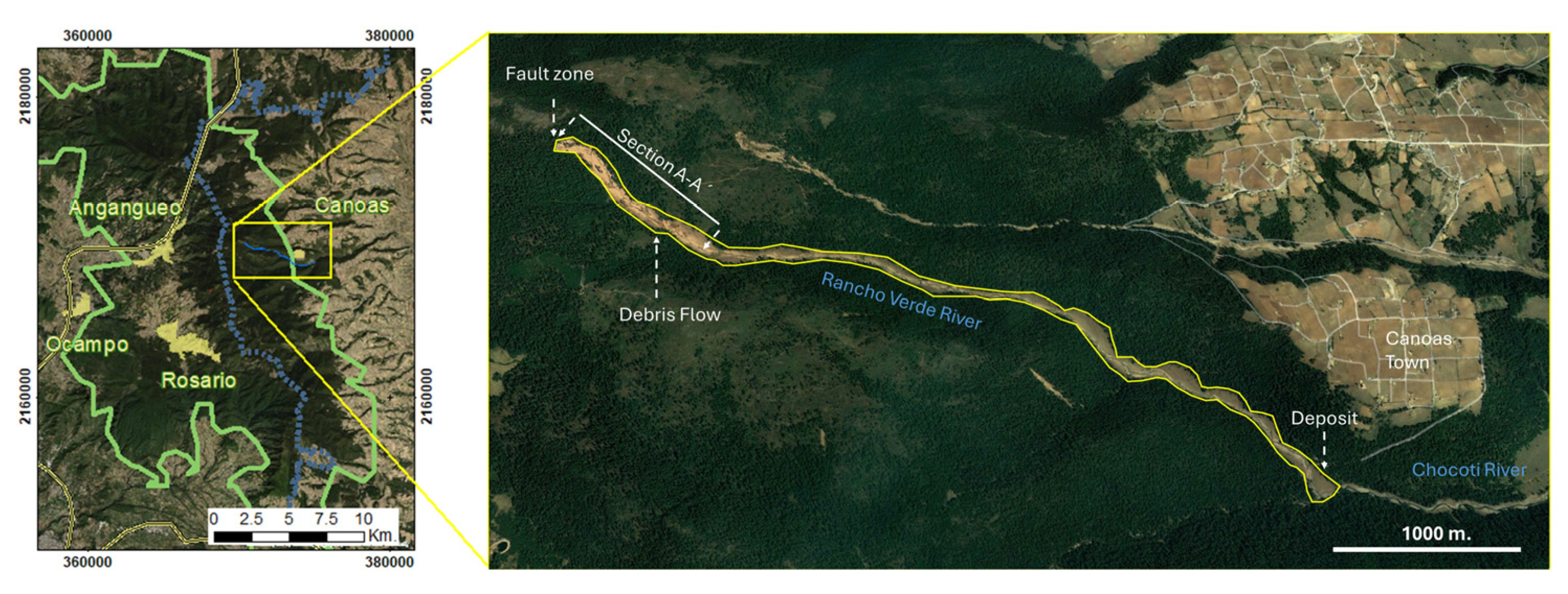
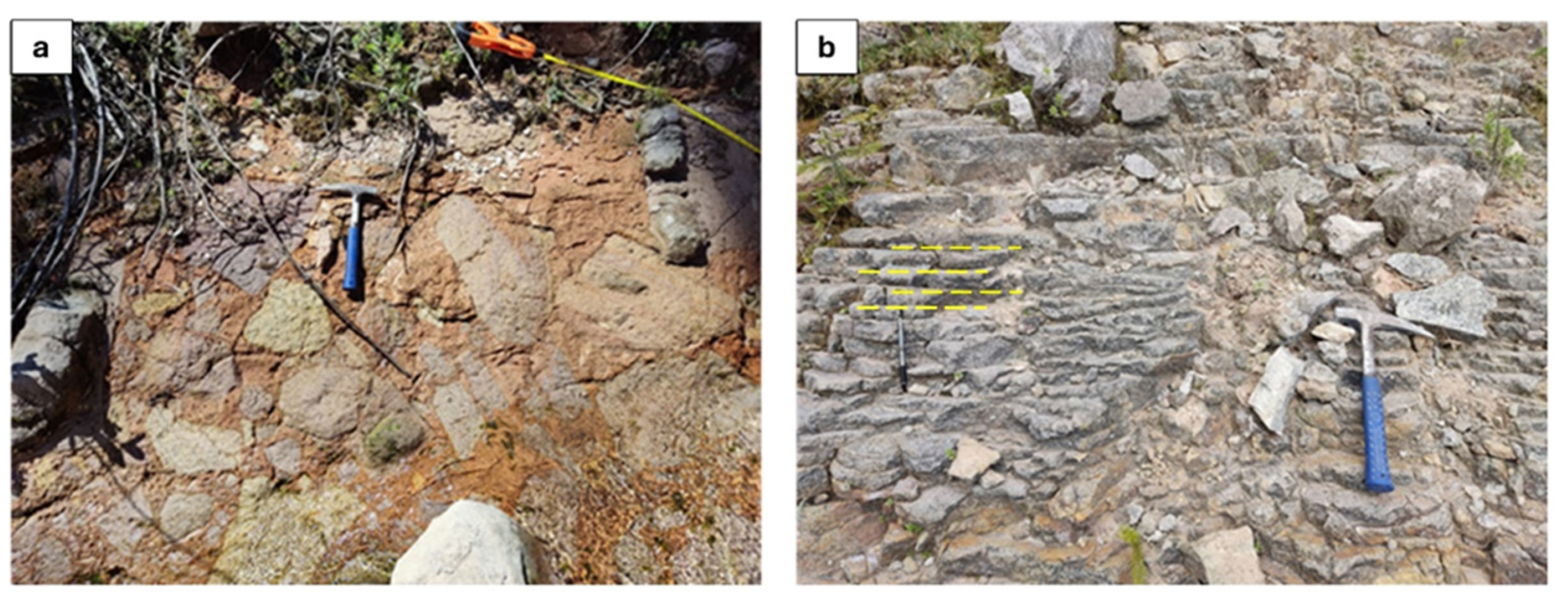
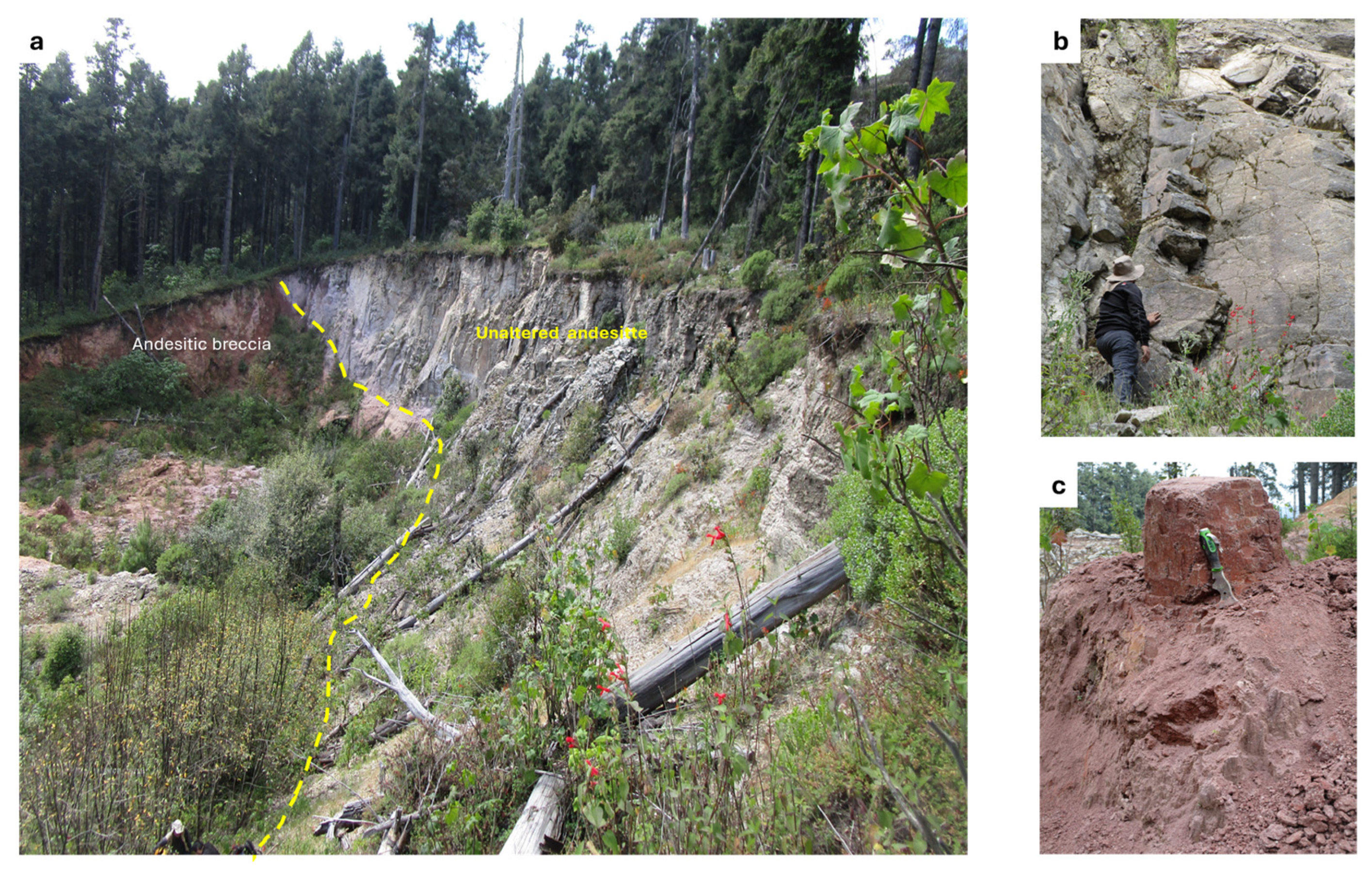
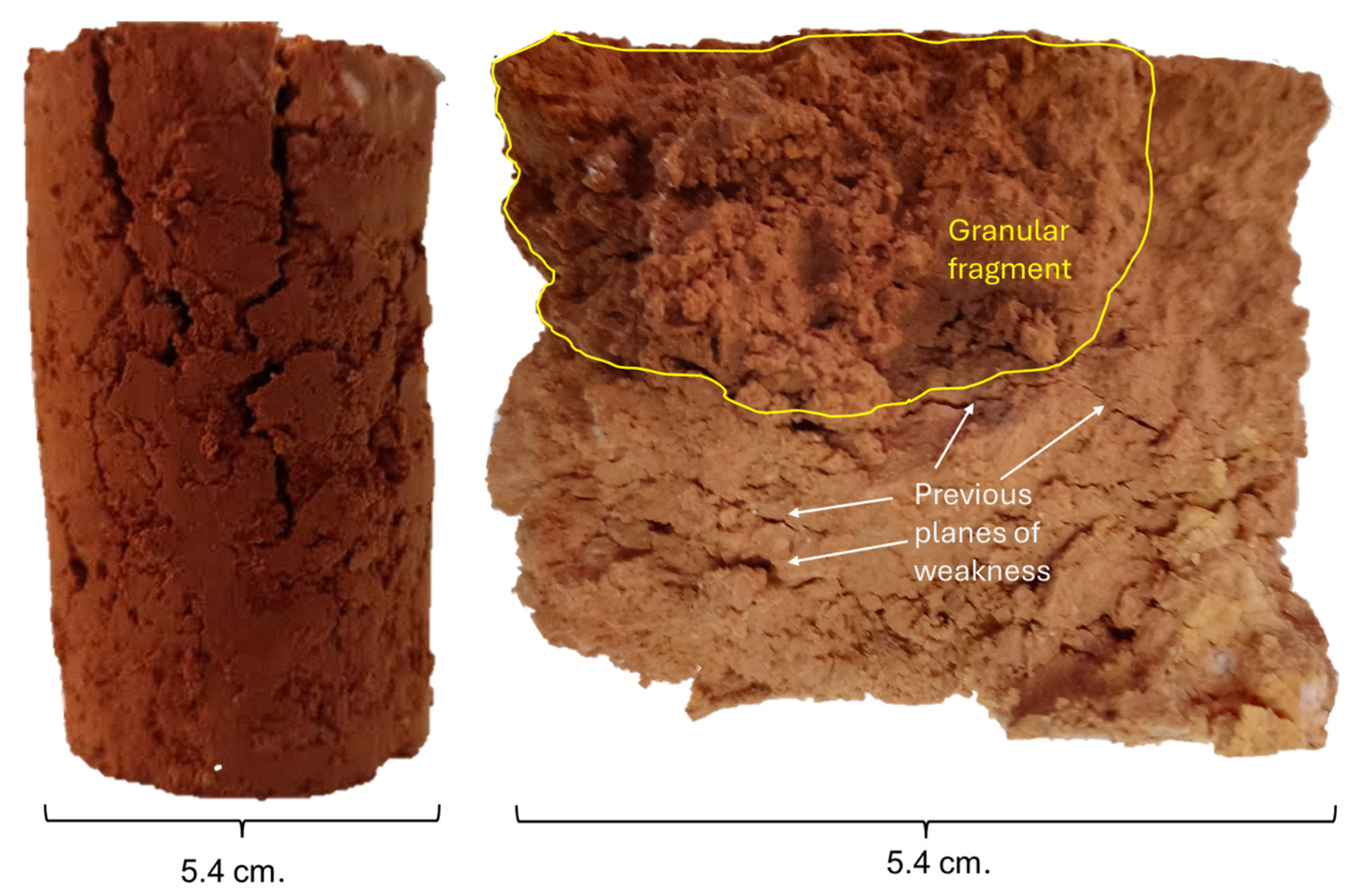
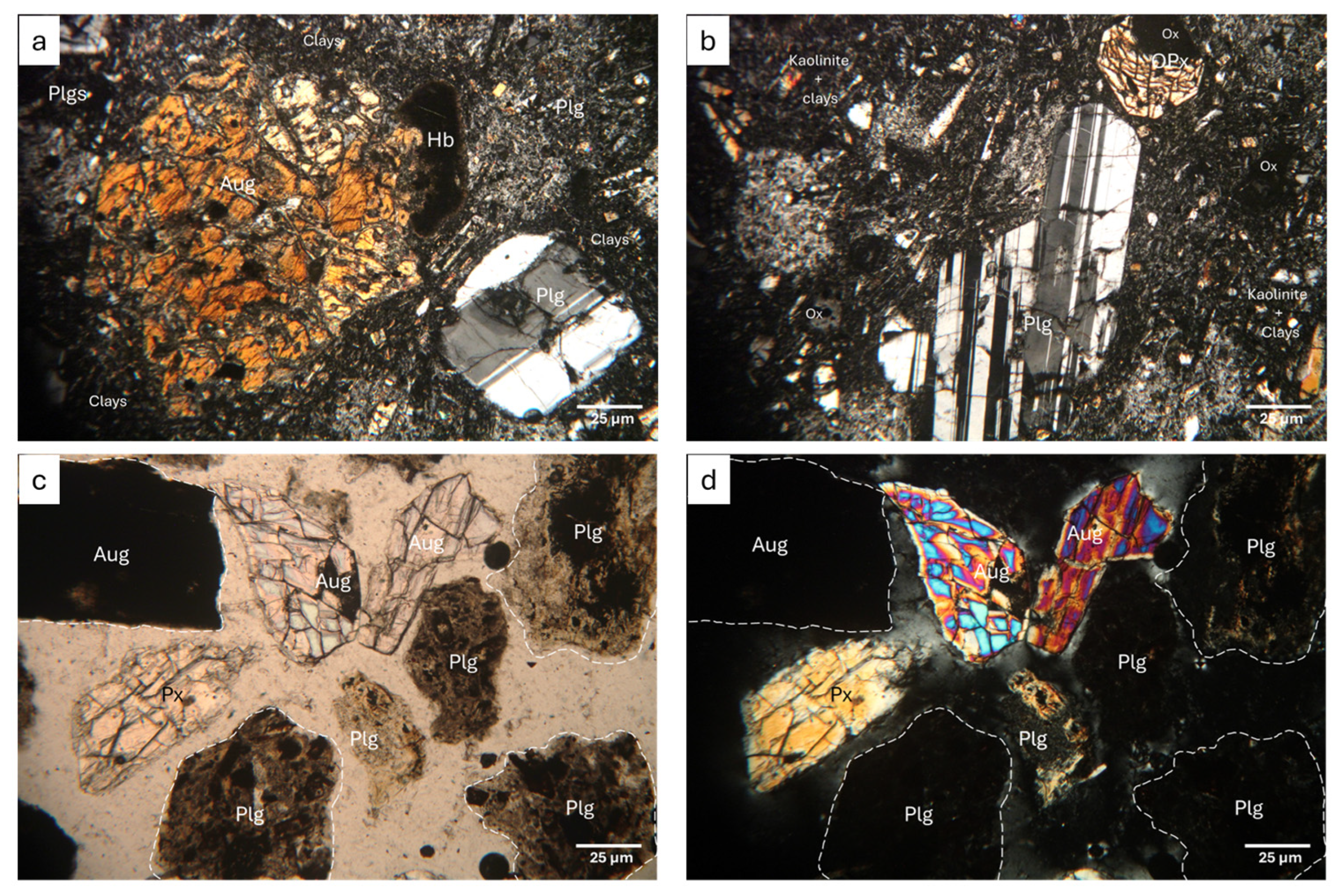
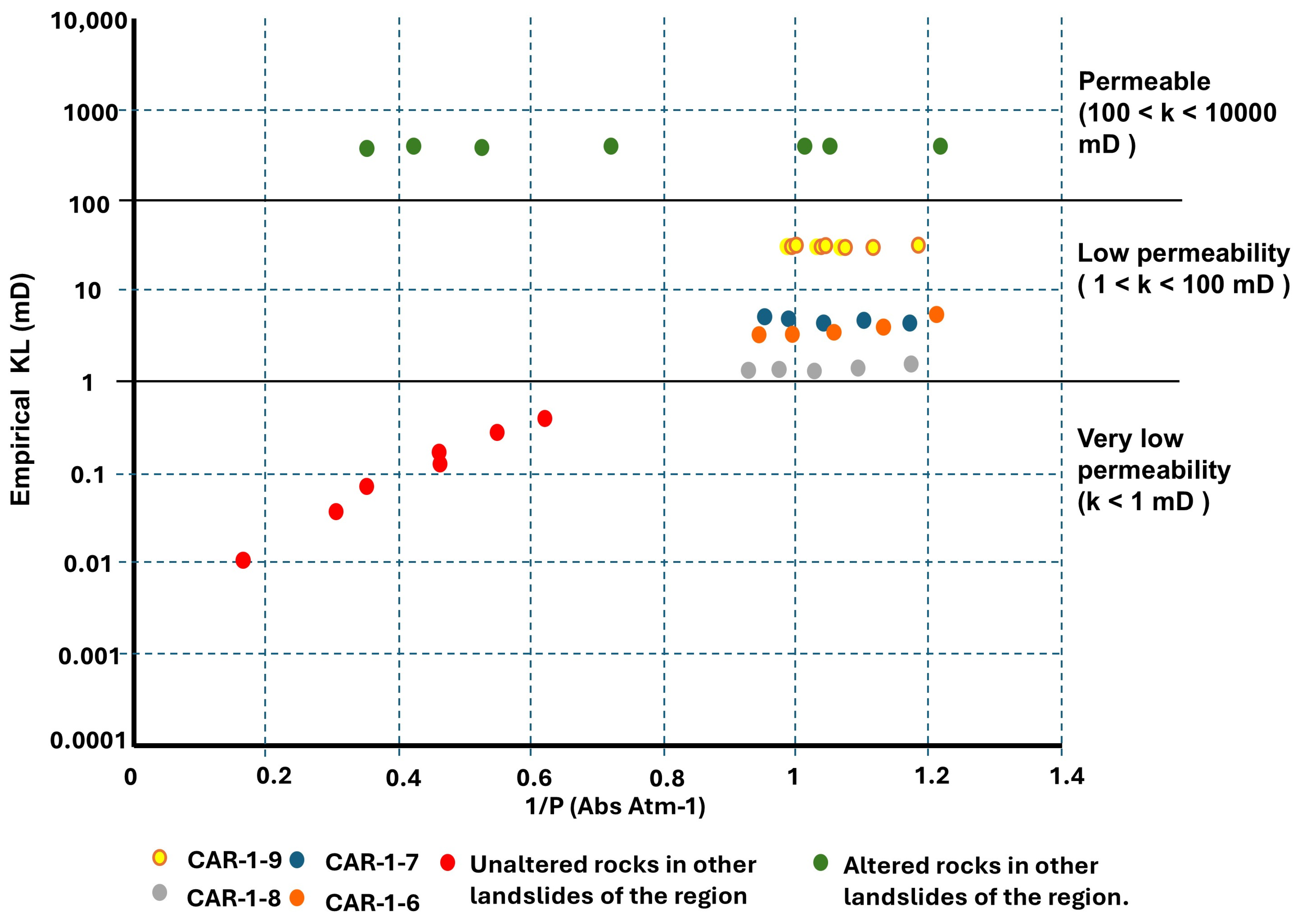
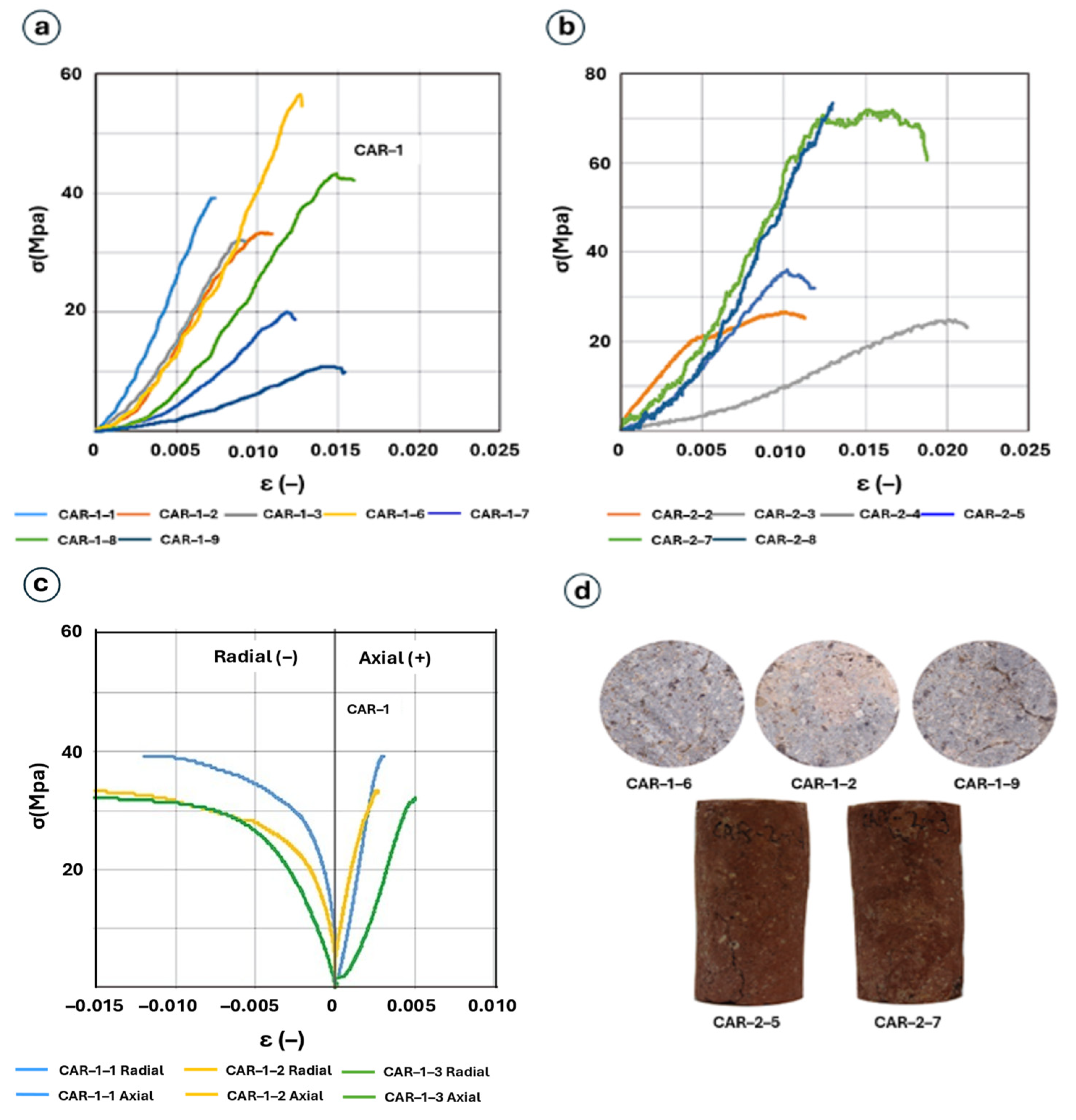

| ID Sample | Coordinates UTM Zone 14 N. (Meters) | Description | ||
|---|---|---|---|---|
| X | Y | Z | ||
| CAR-1 | 370,394 | 217,0276 | 3409 | Light gray andesite features vertical joints and areas of intense horizontal sheeting, alternating with a massive structure. |
| CAR-2 | 370,398 | 217,0246 | 3389 | Dark red andesitic breccia rich in iron oxide and highly argillically altered. |
| ID | CAR-1 | CAR-2 |
|---|---|---|
| Wm (%) | 1.98 | 26.66 |
| ρr (g/cm3) | 2.636 ± 0.000 | 2.68 ± 0.00 |
| ρbg (g/cm3) | 2.376 ± 0.002 | 1.056 ± 0.002 |
| ρbh (g/cm3) | 2.33 ± 0.003 | - |
| k (mD) | 1.82 ± 1.60 | - |
| k (m2) | 1.79619986 × 10−15 | - |
| Ht (%) | 11.730 ± 5.040 | - |
| ηe (%) | 8.40 ± 3.068 | - |
| ηC/ηT | 73.340 ± 18.30 | - |
| σt (MPa) | 3.860 ± 1.962 | - |
| σmax (MPa) | 36.26 ± 18.62 | 0.47 ± 0.05 |
| E (GPa) | 4.916 ± 0.257 | 0.046 ± 0.001 |
| ν (−) | 0.313 ± 0.001 | - |
| Granulometry | ||
|---|---|---|
| Mesh Number # | % Passing | |
| CAR-2-1 | CAR-2-2 | |
| 10 (2 mm) | 99.97 | 97.34 |
| 20 (0.841 mm) | 99.67 | 84.09 |
| 40 (0.4 mm) | 98.64 | 68.82 |
| 60 (0.25 mm) | 97.08 | 58.11 |
| 100 (0.149 mm) | 95.17 | 48.41 |
| 200 (0.074 mm) | 92.49 | 39.58 |
| Atterberg Limits | ||
| Humidity % | 72.63 | 64.5 |
| Liquid Limit % | 97.91 | 37.67 |
| Plastic Limit % | 48.53 | 30.58 |
| Plastic Index % | 49.37 | 7.08 |
| Lineal contraction % | 22.6 | 3.3 |
| Classification (USCS) | MH | SM |
Disclaimer/Publisher’s Note: The statements, opinions and data contained in all publications are solely those of the individual author(s) and contributor(s) and not of MDPI and/or the editor(s). MDPI and/or the editor(s) disclaim responsibility for any injury to people or property resulting from any ideas, methods, instructions or products referred to in the content. |
© 2025 by the authors. Licensee MDPI, Basel, Switzerland. This article is an open access article distributed under the terms and conditions of the Creative Commons Attribution (CC BY) license (https://creativecommons.org/licenses/by/4.0/).
Share and Cite
Jiménez López, L.Á.; Sánchez Núñez, J.M.; Pola, A.; Escamilla Casas, J.C.; Sereno, H.I.; Rodríguez Contreras, P.; Serrano Flores, M.E. Hydrothermally Altered Rocks and Their Implications for Debris Flow Generation in the Monarch Butterfly Biosphere Reserve, Mexico. GeoHazards 2025, 6, 62. https://doi.org/10.3390/geohazards6040062
Jiménez López LÁ, Sánchez Núñez JM, Pola A, Escamilla Casas JC, Sereno HI, Rodríguez Contreras P, Serrano Flores ME. Hydrothermally Altered Rocks and Their Implications for Debris Flow Generation in the Monarch Butterfly Biosphere Reserve, Mexico. GeoHazards. 2025; 6(4):62. https://doi.org/10.3390/geohazards6040062
Chicago/Turabian StyleJiménez López, Luis Ángel, Juan Manuel Sánchez Núñez, Antonio Pola, José Cruz Escamilla Casas, Hugo Iván Sereno, Perla Rodríguez Contreras, and María Elena Serrano Flores. 2025. "Hydrothermally Altered Rocks and Their Implications for Debris Flow Generation in the Monarch Butterfly Biosphere Reserve, Mexico" GeoHazards 6, no. 4: 62. https://doi.org/10.3390/geohazards6040062
APA StyleJiménez López, L. Á., Sánchez Núñez, J. M., Pola, A., Escamilla Casas, J. C., Sereno, H. I., Rodríguez Contreras, P., & Serrano Flores, M. E. (2025). Hydrothermally Altered Rocks and Their Implications for Debris Flow Generation in the Monarch Butterfly Biosphere Reserve, Mexico. GeoHazards, 6(4), 62. https://doi.org/10.3390/geohazards6040062






